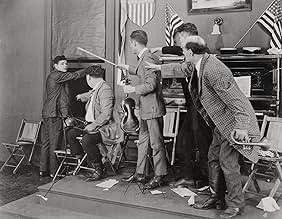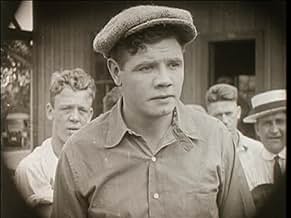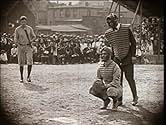The "true story" of baseball great Babe Ruth; Ruth plays himself.The "true story" of baseball great Babe Ruth; Ruth plays himself.The "true story" of baseball great Babe Ruth; Ruth plays himself.
- Director
- Writers
- Stars
Ralf Harolde
- John Tobin
- (as Ralph Harolds)
Charles Byer
- David Talmadge
- (as Charles Burt)
Ann Brody
- Mrs. Tony Marino
- (as Anne Brodie)
Sammy Blum
- Jimbo Jones
- (as Sam Blum)
Tom Cameron
- Deacon Flack
- (as Thomas Cameron)
- Director
- Writers
- All cast & crew
- Production, box office & more at IMDbPro
Featured reviews
Babe Ruth comes from a hick town and gets involved in a lot of situations. He ends up as a baseball player.
Whoever came up with this idea should have been hit with a baseball bat. An iconic sports figure, one of the most famous of all time, is reduced to a guy growing up in the sticks, rescuing his kid sister's dog from the pound, breaking up a romance between his girl and a louse, and playing very little baseball. This might be suitable for a Charles Ray film, but not a larger-than-life sports legend. Dull in the extreme, I kept dozing off.
I tried to amuse myself by comparing scenes to other films. For instance, Babe is constantly shown whittling a piece of wood to make a bat, like Joe Don Baker in "Walking Tall."
Then, in an exhibition game in his hometown (in which he inexplicably plays for the visiting team), he breaks a bat. His kid sister then hands him his homemade bat, and he hits a homerun, like Robert Redford in "The Natural" (which of course featured Joe Don Baker as "The Whammer," a Babe Ruth knockoff).
After Ruth hits the homerun (again, for the visiting team), the townspeople chase him all over the place - like a Benny Hill sketch (absent Joe Don Baker).
The beginning of Ruth's career, as a pitcher with the Boston Red Sox, is completely ignored. We see very little footage of him playing for the Yankees, and those scenes are just thrown in without any context. Apparently, the filmmakers thought we'd be more interested in Ruth's life pre-baseball, most of which was made up. Big mistake.
Whoever came up with this idea should have been hit with a baseball bat. An iconic sports figure, one of the most famous of all time, is reduced to a guy growing up in the sticks, rescuing his kid sister's dog from the pound, breaking up a romance between his girl and a louse, and playing very little baseball. This might be suitable for a Charles Ray film, but not a larger-than-life sports legend. Dull in the extreme, I kept dozing off.
I tried to amuse myself by comparing scenes to other films. For instance, Babe is constantly shown whittling a piece of wood to make a bat, like Joe Don Baker in "Walking Tall."
Then, in an exhibition game in his hometown (in which he inexplicably plays for the visiting team), he breaks a bat. His kid sister then hands him his homemade bat, and he hits a homerun, like Robert Redford in "The Natural" (which of course featured Joe Don Baker as "The Whammer," a Babe Ruth knockoff).
After Ruth hits the homerun (again, for the visiting team), the townspeople chase him all over the place - like a Benny Hill sketch (absent Joe Don Baker).
The beginning of Ruth's career, as a pitcher with the Boston Red Sox, is completely ignored. We see very little footage of him playing for the Yankees, and those scenes are just thrown in without any context. Apparently, the filmmakers thought we'd be more interested in Ruth's life pre-baseball, most of which was made up. Big mistake.
The movie hardly makes sense. However, its redeeming value is seeing a young Babe Ruth and the historical footage of the Polo Grounds as it appeared in 1920. The highlight is seeing Ruth at bat in a real game -- the pitcher winds and throws and the Babe swings and hits the ball, and then runs the bases. Terrific stuff. Early in the film Babe takes a turn on the mound. Before he gained fame as a hitter he was an outstanding major league pitcher. The scene involves a sandlot game. I'm not sure Babe gave it his actual windup, but it looked good and professional. The view of the Polo Grounds stands shows the largely male crowd in derby and straw hats. The closing shot was taken from the clubhouse area, which was in back of centerfield. It's too bad all this happens at the very end of the picture.
It's rare professional athletes play themselves in numerous films. Baseball's Herman Ruth was that rare exception, portraying himself in ten movies, the first in September 1920's "Headin' Home." The fictional biography of Babe's upbringing and how he broke into professional baseball was filmed during his first season with New York Yankees after the Boston Red Sox sold him for cash in the 1919-1920 off season.
Ruth's ambitions for a lucrative movie career while still playing baseball was a factor in him going to New York. In the tail end of the 1919 season, the Sox outfielder signed a $10,000 contract to appear in film, twice the salary he made in Boston that year. After the season, he traveled to Hollywood. However, the producers soon realized how lousy an actor he was after viewing some screen tests and withdrew the contract. But realizing the easy money that could be made in front of a camera versus playing a physically grueling season for much less encouraged him to demand more money from Boston.
That threat unnerved the Sox owners; hence the payoff of $100,000 they received from the Yankees for the Babe, beginning 'The Curse of the Bambino' for Boston. During the summer 1920 season, when Ruth was breaking home run records, movie moguls realized the potential box office hit this baseball superstar could achieve no matter how bad his acting was. With a $15,000 down payment and $35,000 paid if it was a success, the Babe appeared in his first movie in August in nearby Haverstraw, New York, while he was recovering from an injury to his hand (a bug-bite flared up requiring surgery).
The script detailing his boyhood and how he broke into professional baseball is pure bunk. But the 25-year-old Ruth played himself capably. The few minutes seen in the movie capturing rare footage of him playing baseball at such a young age, both playacting on the diamond as well as clips of him in a Yankee uniform, heightens the interest in "Headin' Home." The movie bombed at the theaters, however, negating the final payment. But the film did serve as an inspiration to Robert Redford's 1984 'The Natural,' where his young Roy Hobbs makes a bat out of a tree just as Ruth did in the movie.
Appearing on the big screen must have motivated Ruth the remainder of the season. He ended up hitting 54 home runs, shattering baseball and his previous record of 29.
Ruth's ambitions for a lucrative movie career while still playing baseball was a factor in him going to New York. In the tail end of the 1919 season, the Sox outfielder signed a $10,000 contract to appear in film, twice the salary he made in Boston that year. After the season, he traveled to Hollywood. However, the producers soon realized how lousy an actor he was after viewing some screen tests and withdrew the contract. But realizing the easy money that could be made in front of a camera versus playing a physically grueling season for much less encouraged him to demand more money from Boston.
That threat unnerved the Sox owners; hence the payoff of $100,000 they received from the Yankees for the Babe, beginning 'The Curse of the Bambino' for Boston. During the summer 1920 season, when Ruth was breaking home run records, movie moguls realized the potential box office hit this baseball superstar could achieve no matter how bad his acting was. With a $15,000 down payment and $35,000 paid if it was a success, the Babe appeared in his first movie in August in nearby Haverstraw, New York, while he was recovering from an injury to his hand (a bug-bite flared up requiring surgery).
The script detailing his boyhood and how he broke into professional baseball is pure bunk. But the 25-year-old Ruth played himself capably. The few minutes seen in the movie capturing rare footage of him playing baseball at such a young age, both playacting on the diamond as well as clips of him in a Yankee uniform, heightens the interest in "Headin' Home." The movie bombed at the theaters, however, negating the final payment. But the film did serve as an inspiration to Robert Redford's 1984 'The Natural,' where his young Roy Hobbs makes a bat out of a tree just as Ruth did in the movie.
Appearing on the big screen must have motivated Ruth the remainder of the season. He ended up hitting 54 home runs, shattering baseball and his previous record of 29.
Telling a simple tale of Babe Ruth's life in his small hometown just before his rise to fame, the intertitles relating the story as it is supposedly known by an "oldtimer" from Babe Ruth's birthplace of Haverlock. Following the goings-on in the town including stuff about various locals, Babe's life at home with his mother and foster-sister (an adorable little gal known as "Pigtails" who sports braids that stick out on each side of her head) and Babe's interest in a local woman who appears to be rather fickle. Babe is seen doing homespun stuff like carving baseball bats out of kindling, letting dogs loose that have been caged by the local dog catcher, and playing in a home town game, batting for the other team!
This is a mildly entertaining film - mainly of interest for the view of a young (and fairly trim) Babe Ruth, who plays himself in this. He gives a somewhat bland performance, his facial expression barely changes no matter what is happening on screen. Nevertheless, he has his charm and comes across as a real nice guy - it is certainly very interesting to see him. Some humor is attempted at in this film, via the title cards - but it pretty much falls flat. The backwoods way of speaking as told by the old man who narrates this comes across as slightly annoying - the word "wuz" is used over and over again, you get the idea. Interesting shot of a sea of men in straw hats pouring into the ball park - and I agree, Pigtails (not to mention her cute little dog) steals the film. The print of this, as seen on the Kino DVD, looks very nice, with a good deal of contrast - the music is an old-fashioned organ score that suits the film. All in all, not a great film - but for baseball and Babe Ruth fans, a must see.
This is a mildly entertaining film - mainly of interest for the view of a young (and fairly trim) Babe Ruth, who plays himself in this. He gives a somewhat bland performance, his facial expression barely changes no matter what is happening on screen. Nevertheless, he has his charm and comes across as a real nice guy - it is certainly very interesting to see him. Some humor is attempted at in this film, via the title cards - but it pretty much falls flat. The backwoods way of speaking as told by the old man who narrates this comes across as slightly annoying - the word "wuz" is used over and over again, you get the idea. Interesting shot of a sea of men in straw hats pouring into the ball park - and I agree, Pigtails (not to mention her cute little dog) steals the film. The print of this, as seen on the Kino DVD, looks very nice, with a good deal of contrast - the music is an old-fashioned organ score that suits the film. All in all, not a great film - but for baseball and Babe Ruth fans, a must see.
For anyone wanting to find out about the real life Babe Ruth, this "true story" should be avoided at all costs! Created in 1920, this film purports to be about the Bambino and his rise to fame, but frankly almost none of it bears any similarity to the slugger. In the film, he's a small town boy who is shy and unassuming. In real life, he grew up in the "rustic small town" of Baltimore, Maryland and was a bit of a juvenile delinquent--but I guess this image makes for a rather unappealing film! Now the fact that they played so fast and loose with the facts wasn't totally awful--after all, many of our heroes of times past have an aura of fiction about them. But the fiction they created is so schmaltzy and saccharine that it becomes almost laughable. Babe does practically everything in the film but walk on water and heal the sick! The fact that many at the time believed this is what is so amazing about this film. The only truth in the film is that the writers describe his as ugly--something I am surprised Ruth allowed. I guess he wasn't too hung up about his looks.
Speaking of looks, Babe is quite young in the film--and rather trim after his first season with the Yankees. Oddly, though, he'd been a very famous pitcher with the Red Sox but this is never alluded to in the film--but his prowess with the bat sure is. In fact, in the movie he made the bat himself--something reminiscent of Robert Redford's character in THE NATURAL.
Now I am sure you gather that the historical aspects of this film are dubious, at best. As for the entertainment value and quality of the film, it's not bad--especially for 1920. While people today will most likely laugh at the silly and over-the-top plot, the audience of 1920 ate it up and the film was well-produced and kept my interest.
Overall, I give it a 7 as entertainment and a 1 for historical accuracy!
Speaking of looks, Babe is quite young in the film--and rather trim after his first season with the Yankees. Oddly, though, he'd been a very famous pitcher with the Red Sox but this is never alluded to in the film--but his prowess with the bat sure is. In fact, in the movie he made the bat himself--something reminiscent of Robert Redford's character in THE NATURAL.
Now I am sure you gather that the historical aspects of this film are dubious, at best. As for the entertainment value and quality of the film, it's not bad--especially for 1920. While people today will most likely laugh at the silly and over-the-top plot, the audience of 1920 ate it up and the film was well-produced and kept my interest.
Overall, I give it a 7 as entertainment and a 1 for historical accuracy!
Did you know
- TriviaBabe Ruth received $25,000 for this, his first film. The sum was a large amount for the time, and Ruth refused to cash his paycheck and carried it around to show to friends. By the time Ruth had decided to cash his check for the film, the check bounced because of the film's poor box office results. Ruth shrugged off his loss and kept the check as a memento.
- ConnectionsFeatured in Fractured Flickers: Rod Serling (1963)
Details
- Runtime1 hour 11 minutes
- Color
- Sound mix
- Aspect ratio
- 1.33 : 1
Contribute to this page
Suggest an edit or add missing content

























